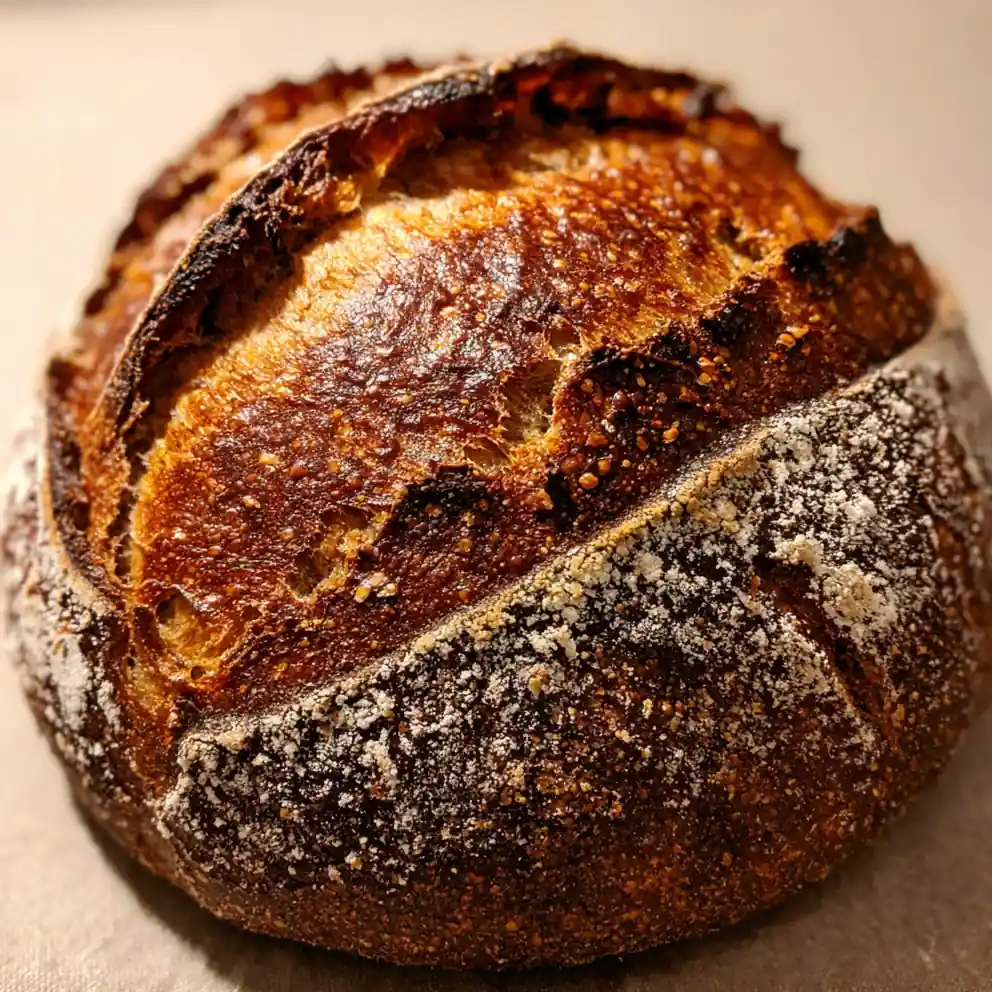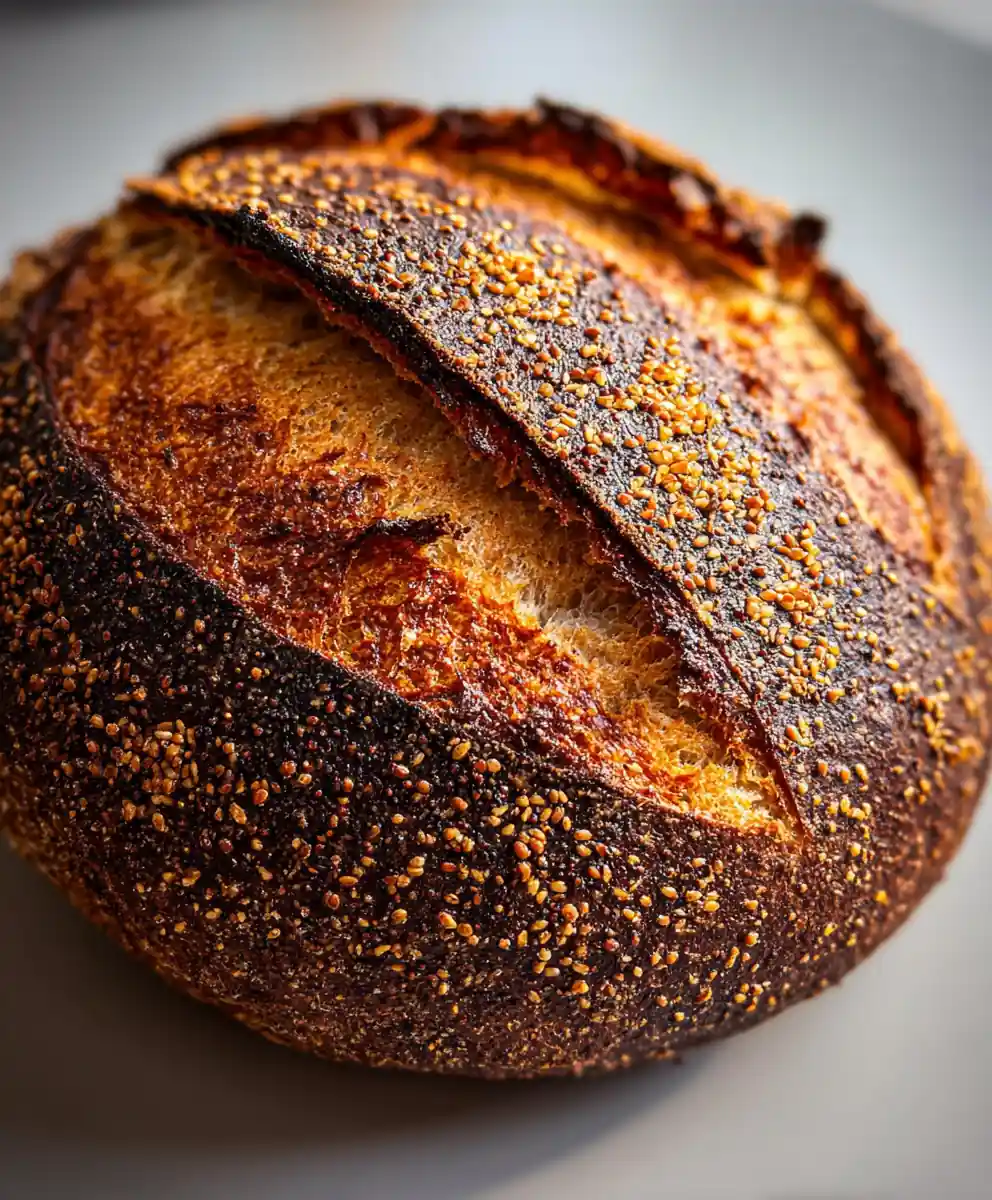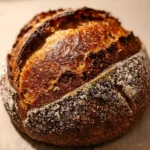I often find myself craving a bread that’s anything but ordinary for our family dinners. This sourdough rye bread recipe Caraway Crust With Cacao Dust answers that call, bringing together robust rye, tangy sourdough, aromatic caraway, and a hint of unexpected richness from cacao. The aroma alone, a warm blend of earthy rye and sweet caraway, makes everyone eager for a slice. It’s a true labor of love with minimal hands-on time, perfect for busy home cooks wanting artisan-quality bread. Get ready to bake a loaf that’s not just food, but an experience!

Ingredient List with Smart Choices
Crafting a truly exceptional sourdough rye bread recipe Caraway Crust With Cacao Dust begins with selecting quality ingredients.
Core Ingredients for Your Hearty Loaf:
To make this delicious sourdough rye bread recipe Caraway Crust With Cacao Dust, you’ll need a few key items.
- Active sourdough starter: 100g (1/2 cup), fed and bubbly, for optimal lift and tangy flavor.
- Dark or light rye flour: 150g (1 1/4 cups) for signature flavor and texture.
- All-purpose or bread flour: 350g (2 3/4 cups) for crumb structure (bread flour adds more chew).
- Water: 350g (1 1/2 cups) lukewarm (around 95°F / 35°C) to activate the starter effectively.
- Fine sea salt: 10g (2 tsp) essential for flavor and fermentation control.
- Whole caraway seeds: 2 Tbsp (18g) for that iconic, aromatic crust (fennel seeds are a good swap for a different anise note).
- Unsweetened cacao powder: 1 Tbsp (5g) for a subtle, sophisticated depth to the crust (or good quality unsweetened cocoa powder if cacao isn’t on hand).
Everyday Pantry Items vs. Fresh Market Picks:
Most flours, salt, caraway, and cacao are readily available pantry staples. Your sourdough starter, however, is a living ‘fresh’ ingredient – keep it happy and active by feeding it regularly!
Highlight Special Diet Options & Swaps:
For a less dense loaf, simply adjust the rye flour to all-purpose flour ratio. Consider adding 1 Tbsp of vital wheat gluten for extra chew (optional). This bread is naturally dairy-free. For a gluten-friendly option (not gluten-free), a longer fermentation can aid digestion, fitting into healthy eating plans.
Seasonal Upgrades or Affordable Substitutions:
No caraway seeds? Try fennel seeds for a different anise-like note on your hearty loaf. Experiment with different cacao dust concentrations for varying intensity, from a faint hint to a more pronounced, earthy finish.
Easy Step-by-Step Cooking Directions
Follow these clear, step-by-step instructions for your sourdough rye bread recipe Caraway Crust With Cacao Dust.
Clear Numbered Steps for Your Sourdough Rye Bread Recipe:
- Feed Your Starter: The night before, feed your sourdough starter so it’s active and bubbly (8-12 hours). It should smell sweet and yeasty, and pass the float test.
- Mix the Dough (Autolyse): In a large mixing bowl, combine rye flour, bread/all-purpose flour, water, and starter. Mix until just combined and shaggy. Cover and let rest for 30 minutes at room temperature.
- Add Salt & Fold: Incorporate fine sea salt. Perform a series of gentle stretch and folds every 30 minutes for 2-3 hours (4-6 sets total). The dough will start to feel smoother and gain strength. If the dough feels too stiff, add a tiny splash (1-2 tsp) of water to help incorporate the salt evenly.
- Bulk Fermentation: Cover the bowl and let the dough bulk ferment at room temperature (70-75°F / 21-24°C) for 4-8 hours. It should noticeably increase in volume and show small bubbles on the surface.
- Pre-shape: Gently turn the dough onto a lightly floured surface. Gently shape into a loose round or oval, cover, and rest for 20-30 minutes. The dough should feel relaxed and spread slightly.
- Final Shape: Shape the dough into its final loaf form, building tension on the surface to create a taut skin.
- Proofing (Cold Fermentation): Place the shaped dough seam-side up in a floured banneton or bowl lined with a floured kitchen towel. Cover and refrigerate for 12-18 hours. This develops deep flavor and firms the dough for easier scoring.
- Preheat Oven & Dutch Oven: Preheat oven to 450°F (230°C) with a Dutch oven inside for at least 30 minutes. The Dutch oven should be smoking hot to the touch.
- Prepare Crust: Mix 2 Tbsp caraway seeds and 1 Tbsp unsweetened cacao powder in a small bowl. This blend makes our distinctive sourdough rye bread recipe Caraway Crust With Cacao Dust truly special.
- Score & Bake: Carefully remove the hot Dutch oven. Invert dough onto parchment paper. Dust the top generously with the caraway-cacao mixture. Score the top of the loaf with a sharp knife or lame (1/2-inch deep). Gently lower into the hot Dutch oven.
- Bake Covered: Bake covered for 25 minutes. The crust will start to set and the loaf will begin to rise.
- Bake Uncovered: Remove lid and bake for another 20-30 minutes, or until the crust is deep golden brown and the internal temperature reaches 200-210°F (93-99°C). Your sourdough rye bread will sound hollow when tapped. I often use my instant-read thermometer to ensure perfect doneness.
- Cool: Transfer the loaf to a wire rack and cool completely (at least 2 hours) before slicing. This ensures the crumb sets fully and the flavors develop.
Inline Shortcuts for Busy Cooks:
Sourdough baking doesn’t have to be a multi-day ordeal if you plan ahead.
- Overnight Proof: The cold proof (Step 7) is your best friend for a flexible schedule – bake this hearty sourdough rye bread recipe straight from the fridge in the morning for fresh bread with minimal morning fuss!
- No-Knead Method: This sourdough technique relies on gentle stretch and folds rather than intensive kneading, making it less hands-on and very approachable for beginners.
Notes for Flavor Variations or Healthier Twists:
Customizing your sourdough rye bread recipe Caraway Crust With Cacao Dust can make it even more family-friendly.
- For a milder rye flavor, use light rye flour instead of dark.
- Add a tablespoon of black strap molasses to the dough during mixing for a darker crumb and deeper flavor profile.
- Incorporate 1/2 cup of chopped walnuts or sunflower seeds during the bulk fermentation for added texture and a boost of healthy fats, making it a nutritious snack.
Ideal Uses and Serving Suggestions
Occasions for Your Sourdough Rye Bread Recipe Caraway Crust With Cacao Dust:
- Weeknight Dinners: Elevates simple meals like soup or stew, transforming ordinary into extraordinary.
- Kid Lunches: Makes fantastic, hearty sandwiches that keep little bellies full and happy.
- Holiday Gatherings: A unique, impressive bread for any festive spread, sure to spark conversation.
- Brunch: Toasted with eggs and avocado for a satisfying and healthy start to your day.
Pairings for a Perfect Bite:
This versatile loaf complements both savory and sweet dishes, making it a staple for any meal.
- Savory: Pairs wonderfully with strong cheeses, rich smoked meats, crisp pickles, and hearty stews.
- Sweet: Try it lightly toasted with butter and a drizzle of honey, or with your favorite fruit preserves for a delightful contrast.
- Drinks: Complements robust coffees, dark beers, or even a glass of dry red wine.
Guidance for Leftovers, Storage, and Reheating:
Proper storage ensures your delicious sourdough rye bread stays fresh for longer, perfect for meal prep.
Store cooled sourdough rye bread in a bread box or tightly wrapped in plastic/beeswax wrap at room temperature for 3-4 days. For longer storage, slice the loaf and freeze individual slices in a freezer-safe bag for up to 3 months. Reheat slices in a toaster or a whole loaf wrapped in foil in a 350°F (175°C) oven for 10-15 minutes until warmed through, offering quick meals even on busy days.
Everyday Benefits of Cooking with Sourdough Rye Bread
Showcase Practical Wins:
While fermentation takes time, the active prep for this sourdough rye bread recipe is surprisingly quick, making it perfect for quick dinner ideas or weekend baking. Making your own bread is far cheaper than buying artisan loaves, presenting a smart choice for budget meal prep. Sourdough fermentation can enhance nutrient availability and aid digestion, making it a healthy recipe for families looking for nutritious snacks and meals.
Tie to Balanced Lifestyle Goals:
- This bread fits beautifully into a healthy eating plan, offering complex carbohydrates and fiber.
- Excellent for meal prep lunches – just slice and store for easy sandwich making throughout the week.
- Provides a satisfying and delicious base for quick dinner ideas when paired with simple toppings or sides.

Tips, Variations, and Dietary Adjustments
Technique Upgrades to Improve Results:
A robust, active starter fed regularly is crucial for good oven spring and a lighter crumb. Use a sharp blade or lame with confident, quick cuts for beautiful ‘ear’ formation and controlled expansion. Baking in a preheated Dutch oven creates essential steam, ensuring a crisp crust and impressive rise.
Flavor/Spice Tweaks for Different Cuisines:
For a more traditional German flavor, add a tablespoon of caraway seeds directly into the dough and a touch of molasses for deep color. Incorporate orange zest or a pinch of ground cardamom into the dough for a fragrant and bright Nordic-inspired twist. Mix in a quarter cup of chopped olives or sun-dried tomatoes (omit cacao for this savory variation) during bulk fermentation for a rustic Italian profile.
Adjustments for Common Diets:
While salt is key for flavor and structure, you can reduce the added fine sea salt by 1/4 teaspoon if desired. Increase the proportion of whole rye flour to up to 70% of the total flour for a denser, more fibrous, and assertive loaf. My own little ones are sometimes a bit shy of too much caraway, so I often adjust the crust dusting to just a light sprinkle. I also sometimes add a handful of dried cranberries to the dough for a touch of natural sweetness they love.
Frequently Asked Questions
Is this sourdough rye bread recipe Caraway Crust With Cacao Dust suitable for gluten-free diets?
No, rye flour contains gluten. While sourdough fermentation can aid digestion for some, this sourdough rye bread recipe is not suitable for strictly gluten-free diets.
How can I meal prep with this sourdough rye bread recipe for the week?
Slice the cooled loaf and store individual portions. It’s excellent for sandwiches or alongside salads and soups throughout the week, making healthy eating simple.
What’s the best way to store homemade sourdough rye bread?
Store it at room temperature in a bread box or tightly wrapped to keep it fresh for 3-4 days. For longer periods, slice and freeze portions, perfect for future quick meals.
Can I make this sourdough rye bread without a Dutch oven?
Yes, you can bake it on a preheated baking steel or stone. To create steam, place a tray of hot water on the bottom rack of your oven during the initial covered baking phase.
What does the cacao dust add to the caraway crust?
The cacao dust adds a subtle, earthy richness and a beautiful dark hue to the crust. It complements the robust flavor of the rye and caraway without making the bread taste sweet, creating a premium ingredient experience.
My sourdough rye bread is too dense. What went wrong?
This could be due to an inactive starter, under-proofing, or using too high a percentage of rye flour without sufficient gluten development from other flours. Ensure your starter is very active and allow ample bulk fermentation time for this sourdough rye bread recipe.
How do I get a really crispy caraway-cacao crust?
Ensure your Dutch oven and oven are fully preheated; the initial covered bake traps steam for a beautiful rise. Then, I like to bake it uncovered for the last 20-30 minutes to really crisp up the sourdough rye bread crust beautifully.
Conclusion
There’s nothing quite like the satisfaction of pulling a warm, aromatic loaf of homemade sourdough rye bread Caraway Crust With Cacao Dust from your oven; it’s a rewarding process that truly elevates family dinners. Embrace this unique, healthy recipe journey for delicious homemade bread and save it to your Pinterest board for future baking inspiration!

sourdough rye bread recipe Caraway Crust With Cacao Dust
- Total Time: 1680 minutes
- Yield: 1 loaf 1x
- Diet: Dairy-Free, General
Description
This sourdough rye bread combines robust rye, tangy sourdough, aromatic caraway, and a hint of cacao for a unique flavor and aroma. It’s a labor of love with minimal hands-on time, resulting in artisan-quality bread.
Ingredients
- 100 g active sourdough starter, fed and bubbly
- 150 g dark or light rye flour
- 350 g all-purpose or bread flour
- 350 g water, lukewarm (around 95(deg)F / 35(deg)C)
- 10 g fine sea salt
- 2 Tbsp (18 g) whole caraway seeds
- 1 Tbsp (5 g) unsweetened cacao powder
Instructions
- Feed Your Starter: The night before, feed your sourdough starter so it’s active and bubbly (8-12 hours). It should smell sweet and yeasty, and pass the float test.
- Mix The Dough Autolyse: In a large mixing bowl, combine rye flour, bread or all-purpose flour, water, and starter. Mix until just combined and shaggy. Cover and let rest for 30 minutes at room temperature.
- Add Salt And Fold: Incorporate fine sea salt. Perform a series of gentle stretch and folds every 30 minutes for 2-3 hours (4-6 sets total). The dough will start to feel smoother and gain strength. If the dough feels too stiff, add a tiny splash (1-2 tsp) of water to help incorporate the salt evenly.
- Bulk Fermentation: Cover the bowl and let the dough bulk ferment at room temperature (70-75(deg)F / 21-24(deg)C) for 4-8 hours. It should noticeably increase in volume and show small bubbles on the surface.
- Pre-shape The Dough: Gently turn the dough onto a lightly floured surface. Gently shape into a loose round or oval, cover, and rest for 20-30 minutes. The dough should feel relaxed and spread slightly.
- Final Shape: Shape the dough into its final loaf form, building tension on the surface to create a taut skin.
- Proof The Dough: Place the shaped dough seam-side up in a floured banneton or bowl lined with a floured kitchen towel. Cover and refrigerate for 12-18 hours. This develops deep flavor and firms the dough for easier scoring.
- Preheat Oven And Dutch Oven: Preheat oven to 450(deg)F (230(deg)C) with a Dutch oven inside for at least 30 minutes. The Dutch oven should be smoking hot to the touch.
- Prepare Crust Mixture: Mix 2 Tbsp caraway seeds and 1 Tbsp unsweetened cacao powder in a small bowl.
- Score And Bake: Carefully remove the hot Dutch oven. Invert dough onto parchment paper. Dust the top generously with the caraway-cacao mixture. Score the top of the loaf with a sharp knife or lame (0.5-inch deep). Gently lower into the hot Dutch oven.
- Bake Covered: Bake covered for 25 minutes.
- Bake Uncovered: Remove lid and bake for another 20-30 minutes, or until the crust is deep golden brown and the internal temperature reaches 200-210(deg)F (93-99(deg)C).
- Cool The Loaf: Transfer the loaf to a wire rack and cool completely (at least 2 hours) before slicing.
Notes
The cold proof (Step 7) allows for a flexible baking schedule. This sourdough technique uses gentle stretch and folds, making it approachable for beginners. For a milder rye flavor, use light rye flour. Add 1 Tbsp black strap molasses for a darker crumb and deeper flavor. Incorporate 0.5 cup chopped walnuts or sunflower seeds for added texture and healthy fats.
- Prep Time: 40 minutes
- Cook Time: 55 minutes
- Category: Bread
- Method: Baking
- Cuisine: European
Nutrition
- Serving Size: 1 slice (60 g)
- Calories: 120 calories
- Sugar: 2 g
- Sodium: 250 mg
- Fat: 1 g
- Saturated Fat: 0.5 g
- Unsaturated Fat: 0.5 g
- Trans Fat: 0 g
- Carbohydrates: 22 g
- Fiber: 3 g
- Protein: 4 g
- Cholesterol: 0 mg
Keywords: sourdough, rye bread, caraway, cacao, artisan, no-knead, overnight proof, dairy-free, savory bread
